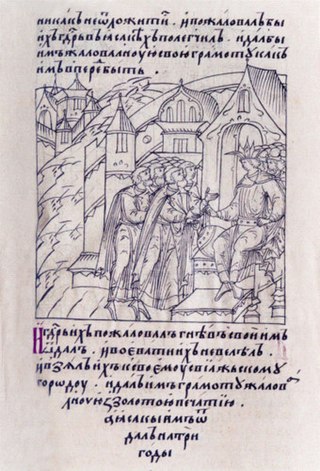
Chuvashia, officially the Chuvash Republic — Chuvashia, is a republic of Russia located in Eastern Europe. It is the homeland of the Chuvash people, a Turkic ethnic group. It borders with the Mari El Republic in the north, Nizhny Novgorod Oblast in the west, the Republic of Mordovia in the southwest, Ulyanovsk Oblast in the south, and the Republic of Tatarstan in the east and southeast. Its capital is the city of Cheboksary. As of the 2010 Census, its population was 1,251,619.
This is a list of units of administrative division of the Republic of Tatarstan, a federal subject of Russia.
Zilant is a legendary creature, something between a dragon and a wyvern. Since 1730, it has been the official symbol of Kazan. This winged snake is mentioned in legends about the foundation of Kazan.

Smolensk Governorate was an administrative-territorial unit (guberniya) of the Tsardom of Russia, the Russian Empire, and the Russian SFSR. It existed, with interruptions, between 1708 and 1929.

Archangelgorod Governorate was an administrative-territorial unit (guberniya) of the Tsardom of Russia and the Russian Empire, which existed from 1708 until 1780. Its seat was in Archangel (Arkhangelsk). The governorate was located in the north of the Russian Empire and bordered Siberia Governorate in the east, Kazan Governorate in the southeast, Moscow and Ingermanland Governorates in the southwest, Sweden in the west, and Norway in north-west. In the north, the governorate was limited by the White and Barents Seas.
The history of Chuvashia spans from the region's earliest attested habitation by Finno-Ugric peoples to its incorporation into the Russian Empire and its successor states.

Siberia Governorate was an administrative-territorial unit (guberniya) of the Tsardom of Russia and the Russian Empire, which existed from 1708 until 1782. Its seat was in Tobolsk. The governorate was located in the east of Russian Empire and bordered China in the south, Kazan Governorate in the southwest, and Archangelgorod Governorate in the northwest. In the north and the east, the governorate was limited by the seas of the Arctic and Pacific Oceans. In terms of area, Siberia Governorate was by far the biggest of all the governorates, as it included areas in the Urals, Siberia, and the Russian Far East some of which were not yet even settled by Russians at the time.

Vyatka Governorate was an administrative-territorial unit (guberniya) of the Russian Empire and the Russian SFSR from 1796 to 1929, with its capital in Vyatka. The area of the governorate roughly corresponds to modern-day Kirov Oblast and Udmurtia.

Ufa Governorate was an administrative-territorial unit (guberniya) of the Russian Empire with its capital in the city of Ufa. It was created in 1865 by separation from Orenburg Governorate. On June 14, 1922 the governorate was transformed into the Bashkir Autonomous Soviet Socialist Republic. It occupied an area of 122,005 square kilometres (47,106 sq mi) and the territory of governorate was divided to six uyezds.

Azov Governorate was an administrative-territorial unit (guberniya) of the Russian Empire, which existed from 1775 to 1783. Its capital was in Belyov Fortress and later in Yekaterinoslav.
Caucasus Governorate was an administrative division (guberniya) of the Russian Empire, which existed from 1802 until 1822. Its seat was located in Georgiyevsk. The governorate was located in the south of the European part of the Russian Empire. In 1822, the governorate was abolished and transformed into Caucasus Oblast, with the administrative center in Stavropol. In terms of modern administrative divisions of Russia, the area of Caucasus Governorate is currently split between Stavropol and Krasnodar Krais, Rostov Oblast, and the Republics of Kabardino-Balkaria, North Ossetia–Alania, Ingushetia, Chechnya, Dagestan, and Kalmykia, with the major part of it being located in Stavropol Krai.

Kiev Governorate was an administrative-territorial unit (guberniya) of the Tsardom of Russia and the Russian Empire. It was established in December 1708 as one of the eight guberniyas first created during the reforms of Peter the Great.

Tver Governorate was an administrative-territorial unit (guberniya) of the Russian Empire and the Russian SFSR, which existed from 1796 until 1929. Its seat was in Tver. The governorate was located in the center of the European part of the Russian Empire and bordered Novgorod Governorate in the north, Yaroslavl Governorate in the east, Vladimir Governorate in the southeast, Moscow Governorate in the south, Smolensk Governorate in the southwest, and Pskov Governorate in the west.

Nizhny Novgorod Governorate was an administrative-territorial unit (guberniya) of the Russian Empire, Russian Republic, and the Russian SFSR, roughly corresponding to the Upper and Middle Volga region and what is now most of the Nizhny Novgorod Oblast. In the early of 20th Century, Nizhny Novgorod Governorate bordered Kostroma and Vyatka governorates to the north, Vladimir Governorate to the west, Kazan and Simbirsk governorates to the east, and Penza with Tambov governorates to the south.
Shoorcha rebellion — uprising against feudal relations Mari, Tatar, Chuvash peasants to protect their property rights in the 19th century.

The entry of Chuvashia into the Russian state was an event in the history of the Chuvash people that occurred in 1551, when the Chuvash of the mountain side became a subject of the Russian state.

Staro-Almetevskaya Volost was an administrative division of Chistopol Uyezd of the Kazan Namestnichestvo until 1796, the Kazan Governorate from 1796 to 1920, then as part of the Chistopol Canton of the Tatar ASSR from 1920 to 1930.
Sviyazhsky Uyezd was one of the subdivisions of the Kazan Governorate of the Russian Empire. It was situated in the central part of the governorate. Its administrative centre was Sviyazhsk.
Tsaryovokokshaysky Uyezd was one of the subdivisions of the Kazan Governorate of the Russian Empire. It was situated in the northwestern part of the governorate. Its administrative centre was Tsaryovokokshaysk (Yoshkar-Ola).
Cheboksarsky Uyezd was one of the subdivisions of the Kazan Governorate of the Russian Empire. It was situated in the western part of the governorate. Its administrative centre was Cheboksary.














